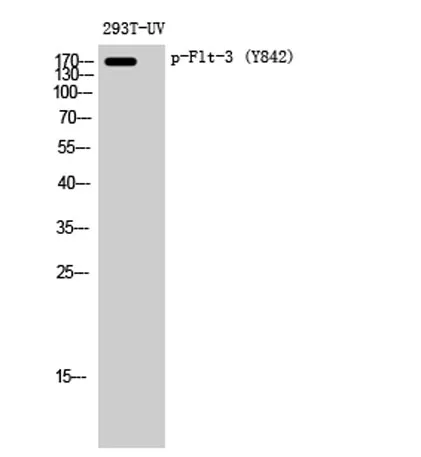Flt-3 (phospho Tyr842) rabbit pAb
CAT:
855-ES5321-02
Size:
100 μL
Price:
Ask
- Availability: 24/48H Stock Items & 2 to 6 Weeks non Stock Items.
- Dry Ice Shipment: No




Flt-3 (phospho Tyr842) rabbit pAb
- Description: This gene encodes a class III receptor tyrosine kinase that regulates hematopoiesis. This receptor is activated by binding of the fms-related tyrosine kinase 3 ligand to the extracellular domain, which induces homodimer formation in the plasma membrane leading to autophosphorylation of the receptor. The activated receptor kinase subsequently phosphorylates and activates multiple cytoplasmic effector molecules in pathways involved in apoptosis, proliferation, and differentiation of hematopoietic cells in bone marrow. Mutations that result in the constitutive activation of this receptor result in acute myeloid leukemia and acute lymphoblastic leukemia. [provided by RefSeq, Jan 2015],
- Synonyms: FLT3; CD135; FLK2; STK1; Receptor-type tyrosine-protein kinase FLT3; FL cytokine receptor; Fetal liver kinase-2; FLK-2; Fms-like tyrosine kinase 3; FLT-3; Stem cell tyrosine kinase 1; STK-1; CD antigen CD135
- Gene ID: 2322
- UniProt: P36888
- Cellular Locus: Membrane; Single-pass type I membrane protein. Endoplasmic reticulum lumen. Constitutively activated mutant forms with internal tandem duplications are less efficiently transported to the cell surface and a significant proportion is retained in an immature form in the endoplasmic reticulum lumen. The activated kinase is rapidly targeted for degradation.
- Host: Rabbit
- Species Reactivity: Human, Mouse
- Immunogen: The antiserum was produced against synthesized peptide derived from human FLT3 around the phosphorylation site of Tyr842. AA range:808-857
- Clonality: Polyclonal
- Validated Applications: WB, ELISA
- Stability: 1 year
- Concentration: 1 mg/mL
- Dilution: Western Blot: 1/500 - 1/2000. ELISA: 1/10000. Not yet tested in other applications.
- Molecular Weight: 170kD
- Storage Conditions: PBS with 0.02% sodium azide and 50% glycerol pH 7.4. Store at -20°C. Avoid repeated freeze-thaw cycles.
